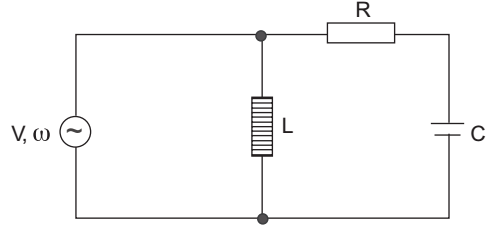Network Elements and the Concept of Circuit
- For a network of 11 branches and 6 nodes, what is the number of independent loops?
-
View Hint View Answer Discuss in Forum
Number of loop,
L = b – n + 1
= 11 – 6 + 1 = 6
Where, b = No. of branches
n = No. of nodes.Correct Option: C
Number of loop,
L = b – n + 1
= 11 – 6 + 1 = 6
Where, b = No. of branches
n = No. of nodes.
- Consider the following circuit:

For what value of, the circuit shown above exhibits unity power factor?
-
View Hint View Answer Discuss in Forum

For unity power factor: Circuit should have pure resistance. ...
∵ This condition will arise when, resonance takes place. When,
Y = G + JB and B = 0Y = 1 + 1 R – JXC JXL or Y = R + JXC - 1 R2 + XC2 XL or Y = R + J 
XC - 1 
R2 + XC2 R2 + XC2 XL
For resonanceXC = 1 R2 + XC2 XL
XC XL = R2 + XC2L = R2 + 1 C ω2C2 L - R2 = 1 C ω2C2 L – R2C = 1 C ω2C2 ω2 = 1 ω2C2 ω2 = 1 LC – R2C2 or ω = 1 √LC – R²C² Correct Option: B

For unity power factor: Circuit should have pure resistance. ...
∵ This condition will arise when, resonance takes place. When,
Y = G + JB and B = 0Y = 1 + 1 R – JXC JXL or Y = R + JXC - 1 R2 + XC2 XL or Y = R + J 
XC - 1 
R2 + XC2 R2 + XC2 XL
For resonanceXC = 1 R2 + XC2 XL
XC XL = R2 + XC2L = R2 + 1 C ω2C2 L - R2 = 1 C ω2C2 L – R2C = 1 C ω2C2 ω2 = 1 ω2C2 ω2 = 1 LC – R2C2 or ω = 1 √LC – R²C²
- Use the data of figure (a). The current i in the circuit of figure (b)—

-
View Hint View Answer Discuss in Forum
This is a reciprocal and linear network. According to reciprocity theorem which states ‘‘Two loops A and B of a network N and if an ideal voltage source E in the loop A produces a current I in loop B, then interchanging positions an identical source in loop B produces the same current in loop A’’. Since network is linear, principle of homogeneity holds and so when voltage source is doubled current will also doubles.
Correct Option: D
This is a reciprocal and linear network. According to reciprocity theorem which states ‘‘Two loops A and B of a network N and if an ideal voltage source E in the loop A produces a current I in loop B, then interchanging positions an identical source in loop B produces the same current in loop A’’. Since network is linear, principle of homogeneity holds and so when voltage source is doubled current will also doubles.
- For the circuit shown below, the Thevenin’s resistance across the terminal A and B is—

-
View Hint View Answer Discuss in Forum

Since here dependent source is connected in the circuit therefore Thevenin’s resistance, Rth is given byRth = VOC ISC
Where,
VOC = Open circuit voltage
ISC = Short circuit current
Calculation of ISC: Equivalent circuit is shown below.ISC = 5V = 2.5 mA 2kΩ 
Calculation of VOC: Equivalent circuit is shown below.
5 = 2I + 3 VAB + 1. I1
or 5 = 6 I1 + 2I2 ....(i)
and 5 = 2I + 2I2
or 5 = 4I1 + 2I1 ....(ii)
From equations (i) and (ii)
I2 = 2I1
and
I1 = 0.5 mA
VAB = VOC = I1 × 1kΩ
= 0.5 mA × 1 kΩ
= 0.5 V
Now,Rth = VOC = 0.5 ISC 2.5 × 10–3
or
Rth = 0.2 kΩ.Correct Option: B

Since here dependent source is connected in the circuit therefore Thevenin’s resistance, Rth is given byRth = VOC ISC
Where,
VOC = Open circuit voltage
ISC = Short circuit current
Calculation of ISC: Equivalent circuit is shown below.ISC = 5V = 2.5 mA 2kΩ 
Calculation of VOC: Equivalent circuit is shown below.
5 = 2I + 3 VAB + 1. I1
or 5 = 6 I1 + 2I2 ....(i)
and 5 = 2I + 2I2
or 5 = 4I1 + 2I1 ....(ii)
From equations (i) and (ii)
I2 = 2I1
and
I1 = 0.5 mA
VAB = VOC = I1 × 1kΩ
= 0.5 mA × 1 kΩ
= 0.5 V
Now,Rth = VOC = 0.5 ISC 2.5 × 10–3
or
Rth = 0.2 kΩ.
- Two two-part networks are connected in parallel. The combination is to be represented as a single two-port network. The parameters of this network are obtained by addition of the individual—
-
View Hint View Answer Discuss in Forum
When the two-port networks are connected in parallel. The equivalent parameters obtained by addition of the individual with the help of y-parameters.
Correct Option: C
When the two-port networks are connected in parallel. The equivalent parameters obtained by addition of the individual with the help of y-parameters.

